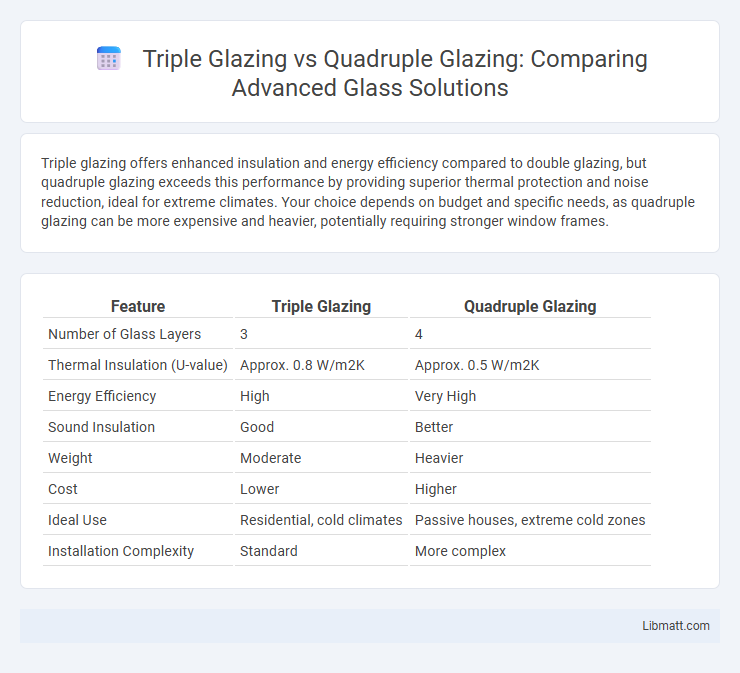Triple glazing offers enhanced insulation and energy efficiency compared to double glazing, but quadruple glazing exceeds this performance by providing superior thermal protection and noise reduction, ideal for extreme climates. Your choice depends on budget and specific needs, as quadruple glazing can be more expensive and heavier, potentially requiring stronger window frames.
Table of Comparison
| Feature | Triple Glazing | Quadruple Glazing |
|---|---|---|
| Number of Glass Layers | 3 | 4 |
| Thermal Insulation (U-value) | Approx. 0.8 W/m2K | Approx. 0.5 W/m2K |
| Energy Efficiency | High | Very High |
| Sound Insulation | Good | Better |
| Weight | Moderate | Heavier |
| Cost | Lower | Higher |
| Ideal Use | Residential, cold climates | Passive houses, extreme cold zones |
| Installation Complexity | Standard | More complex |
Triple Glazing vs Quadruple Glazing: An Overview
Triple glazing consists of three panes of glass separated by insulating gas layers, offering significant improvements in thermal insulation and noise reduction compared to double glazing. Quadruple glazing adds a fourth pane, further enhancing energy efficiency and soundproofing but with increased cost and weight that may require stronger window frames. Your choice between triple and quadruple glazing should consider climate, budget, and structural requirements to maximize comfort and energy savings.
Thermal Insulation Performance Comparison
Quadruple glazing offers superior thermal insulation compared to triple glazing, with a higher overall R-value and lower U-value, reducing heat loss more effectively. The additional pane and gas-filled cavity in quadruple glazing enhance its ability to maintain indoor temperatures and improve energy efficiency. This makes quadruple glazing ideal for colder climates and stringent energy regulations where maximum thermal performance is critical.
Energy Efficiency and Cost Savings
Quadruple glazing offers superior energy efficiency compared to triple glazing by reducing heat loss and enhancing thermal insulation, which can significantly lower your heating and cooling costs. Although the initial investment for quadruple glazing is higher, the long-term cost savings from reduced energy bills often justify the expense. Choosing quadruple glazing helps maximize energy efficiency in colder climates where maintaining indoor temperature is crucial.
Noise Reduction Capabilities
Quadruple glazing offers superior noise reduction capabilities compared to triple glazing due to its additional pane and increased air gap, which enhance sound insulation by dampening a broader range of frequencies. The extra layer in quadruple-glazed windows significantly reduces external noise levels, making them ideal for homes near busy roads or airports. Triple glazing, while effective, provides slightly less soundproofing, balancing noise reduction with cost and weight considerations.
Construction and Material Differences
Triple glazing consists of three glass panes separated by two insulating gas-filled spaces, typically argon or krypton, while quadruple glazing adds a fourth pane and a third gas-filled cavity, enhancing thermal insulation. The additional pane in quadruple glazing increases the window's overall thickness and weight, often requiring stronger frame materials such as reinforced PVC or aluminum to maintain structural integrity. High-quality low-emissivity (Low-E) coatings and advanced spacer bars are used in both systems to reduce heat transfer and prevent condensation, but these components are more complex and costly in quadruple glazing configurations.
Installation Requirements and Challenges
Triple glazing demands less structural reinforcement compared to quadruple glazing due to its lighter weight, facilitating easier installation in existing window frames. Quadruple glazing typically requires sturdier frames and additional support to manage increased weight and thickness, complicating installation in older buildings. Both types may need specialized tools and skilled labor, but quadruple glazing often involves higher costs and longer installation times due to its complexity.
Longevity and Maintenance Considerations
Quadruple glazing offers enhanced durability compared to triple glazing due to its additional glass layer, which provides better protection against wear and environmental factors. Maintenance for quadruple glazing is typically less frequent, as the extra pane improves insulation and reduces condensation, extending the lifespan of seals and frames. Your choice between the two should consider long-term performance and how often you are willing to perform upkeep to maintain optimal energy efficiency.
Environmental Impact and Sustainability
Quadruple glazing offers superior thermal insulation compared to triple glazing, significantly reducing energy consumption for heating and cooling, which lowers carbon emissions and enhances environmental sustainability. The production of quadruple glazing involves more raw materials and energy, potentially increasing its initial carbon footprint, but the long-term energy savings typically offset this impact. Choosing quadruple glazing supports sustainable building practices by improving energy efficiency and contributing to reduced greenhouse gas emissions over the building's lifecycle.
Upfront Costs vs Long-Term Benefits
Triple glazing typically offers a lower upfront cost compared to quadruple glazing, making it a more accessible option for initial investment. Quadruple glazing, although more expensive initially, provides superior insulation that significantly reduces energy consumption and lowers heating bills over time. The long-term benefits of quadruple glazing often outweigh its higher installation costs by enhancing comfort and achieving greater energy efficiency.
Which Glazing Option Is Best For Your Home?
Choosing between triple glazing and quadruple glazing depends on your home's specific energy efficiency needs and climate conditions. Triple glazing offers excellent insulation and noise reduction, making it ideal for most cold climates, while quadruple glazing provides superior thermal performance and energy savings in extreme weather or passive house designs. Your decision should balance upfront costs with long-term benefits in comfort and utility savings.
triple glazing vs quadruple glazing Infographic

 libmatt.com
libmatt.com